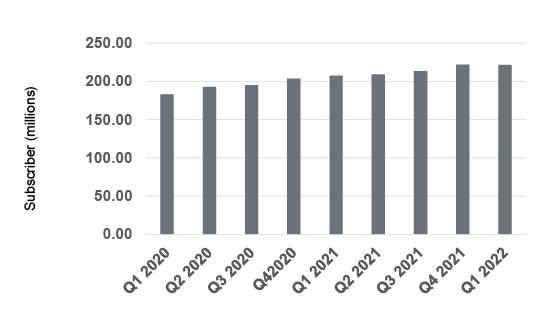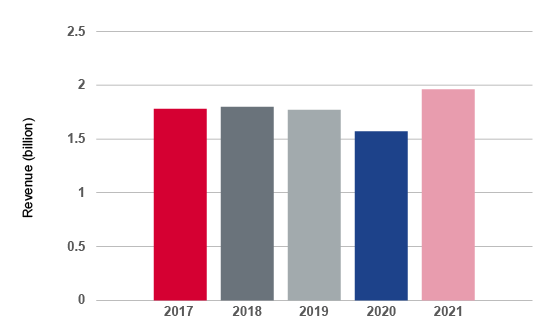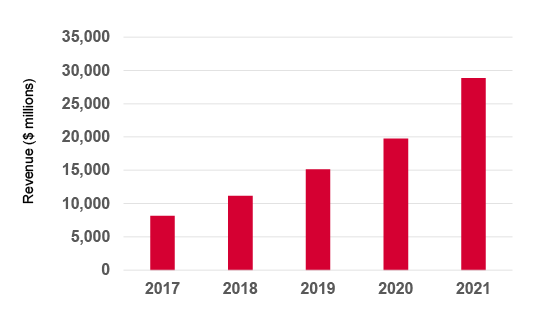


The announcement that Netflix (NFLX – Nasdaq) is to offer a cheaper ad-supported option to subscribers came as no surprise to anyone. Even as far back as 2011 there was pressure on the streaming giant to find a way to make more money in a bid to cover growing costs for content. It held firm and with a little help from lockdowns enjoyed a pandemic boom which saw subscriber numbers soar. But all good things must come to an end and a perfect storm of inflationary pressures, increased competition and the opening up of other forms of entertainment sent Netflix’s numbers tumbling in the wrong direction, with the business warning that worse is still to come.
“Right now, consumers like free, especially younger consumers … people are stopping their video streaming subscriptions in their droves, with 18–24-year-olds leading the charge.”
Netflix subscriber numbers (millions)

Source: Netflix company accounts
Investors have been rattled; billions have been wiped off the company’s value since the start of the year. But the last few weeks have seen a slight shift, a small reversal in sentiment as Netflix plays what many see as it’s trump card. And it might be right. Certainly the dual model has worked brilliantly for music service Spotify (SPOT - NYSE): more than half of its monthly active users choose the free option according to its March trading update. And right now, consumers like free, especially younger consumers. Latest figures from market research firm Kantar suggests that people are stopping their video streaming subscriptions in their droves, with 18–24-year-olds leading the charge. The reason? No surprise, it’s all down to the need to cut costs in a bid to make ends meet.
But is now really the right time to be dallying with advertising – which always takes a hit when economies falter? And exactly how low will Netflix go when it comes to cost? The company hasn’t given much detail about its price point but when you look at how much Roku (ROKU – Nasdaq) pulls in per user (which at the company’s last update was $42.91) you get an idea of what Netflix stands to make on top of any pared down subscription charge. Roku’s Average Revenue Per User (ARPU) has shot up by more than $10 compared to the same period in 2021, and that’s where some alarm bells start to sound.
One of the first areas many companies look to cut costs during times of economic distress is with their marketing and advertising. The first lockdowns took a sizeable bite out of ad spend according to the UK’s Advertising Association, and figures from an Interactive Advertising Bureau survey in March 2020 showed a quarter of US companies paused ad spend in Q2 2020, with nearly half reducing their advertising budgets.
During COVID-19 the travel and hospitality businesses sheared off their ad budgets to save cash. Traditional media bore the brunt, and by taking look at ITV’s (ITV) ad revenue numbers you can see the picture clearly. Ad revenue fell £200m in 2020 and though it’s recovered, and even surpassed levels seen in 2018, the pandemic has shifted the focus of advertisers further into the online space. It’s all about metrics, lots of lovely data that companies can extrapolate and harness to better serve their customers.
ITV Total Advertising Revenue

Source: Company accounts
Whilst ITV’s share price hasn’t taken a Netflix-sized tumble it is down more than 40% over the year to date. It’s potentially got a couple of aces up its sleeve; the first is this winter’s World Cup, that appointment to view that delivers an opportunity for sponsorship deals and sky-high ad buys. Plus, there’s a chance that Ofcom might change the rules and allow longer and more frequent ad breaks as part of a review into broadcasting rules which is expected to be published in the summer. Traditional broadcasters aren’t just battling each other for eyeballs, they’re also having to compete with the streaming services which are spending more and more on content.
And that brings us full circle, back to competition. And when you’re thinking about competition not just for eyeballs but also for advertisers, then Alphabet’s (GOOGL – Nasdaq) YouTube is right at the top of the pile, particularly with younger audiences – those with either pester power or disposable income.
In the same way streaming services seem to have drunk the well dry of paying subscribers there will be a ceiling on how much ad money is floating around as global economies cool.
Its business model is smart. A video-sharing platform where all the content is uploaded by “creators”. Successful content gets ads placed against it via pre-roll displays and creators can get a sizeable chunk of the advertising revenue, sponsorship deals and the opportunity to sell merchandise to fans. Alphabet scoops up the rest of the cash and revenues are soaring.
Worldwide YouTube Advertising Revenue

Source: Company accounts
But YouTube has its own competition in the form of TikTok, and there are plenty of analysts predicting that TikTok’s advertising revenue will surpass that of YouTube in just a couple of years.
In the same way streaming services seem to have drunk the well dry of paying subscribers there will be a ceiling on how much ad money is floating around as global economies cool. Deliveroo (ROO) has just promised investors it’s taking a firmer grip on costs, as it struggles with the cost-of-living crisis which has shifted consumer behaviour, and marketing spend is top of the list when it comes to where it’s making savings.
Companies might know the value of marketing; they might hear warnings that during difficult times they should spend more to position themselves for quick growth when the economic landscape improves. But it’s hard to justify the expense to shareholders when margins are being eroded. Looking at the peaks and troughs over the last couple of years it’s clear ad revenue recovers quickly once those economic shocks are over, but the billion dollar question is how long will this latest economic shock last and will the current inflationary overheat simply stall the engine, or do significantly more damage?
Past performance is not a guide to future performance and some investments need to be held for the long term.
This area of the website is intended for financial advisers and other financial professionals only. If you are a customer of AJ Bell Investcentre, please click ‘Go to the customer area’ below.
We will remember your preference, so you should only be asked to select the appropriate website once per device.